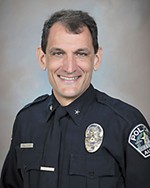Cut-Through City!
North Loop neighbors cry for help
By Jordan Smith, Fri., July 2, 2004

"Let's talk about trucks. Big trucks – the 18-wheeler variety," says Christopher Burnett, a lawyer for the state who lives on 531/2 Street in Austin's Morningside-Ridgetop neighborhood – or, as Burnett might refer to his hood, Dangerous Traffic Central, or even Small-Animal Death Alley. Maybe it's not that bad now, Burnett says, but it will be, unless the city does something – and soon – to curb cut-through traffic coming from the southbound I-35 access road, trying to avoid the 51st Street bottleneck.
For nearly five years, Burnett has been trying to get the city to address the problem and has been lobbying, as yet unsuccessfully, for the city to close the street in its entirety, by blocking off the eastern entrance where it joins the access road, as well as restricting the access on adjacent 52nd and 53rd streets. "We've been trying to go through the proper channels," Burnett said, which so far hasn't worked. "We want solutions ... and the problems keep getting worse."
According to Burnett, since the completion of the U.S. 290 flyover, traffic has continued to increase on the I-35 frontage road, further gumming up traffic at the 51st Street intersection, resulting in habitual traffic delays that prompt irritated drivers to bail out and turn, tires screaming, down his street and onto 52nd and 53rd. That includes trucks, even though their entrance and egress is clearly prohibited. Last month, Burnett says, he saw a gasoline tanker "tooling merrily" down the street, which horrified him, in light of several other recent truck and traffic-related incidents on 531/2 Street.
Last November, Burnett said, he was sitting on his couch watching television, when he was startled by a loud noise. He ran outside, in boxer shorts and flip-flops, just in time to see the tail end of a truck dragging cable and phone lines down the street. Last summer, another truck ripped the cable lines on the street, yanking a connection box from the side of his neighbor's house and dragging it – along with a chunk of the house's siding – down the block. And, when a recent accident on I-35's lower deck caused a traffic backup, Burnett counted 1,100 vehicles in two hours turning down the street, fleeing the nearby jam. "If there is any kind of hiccup on I-35," he said, "we feel it."
And now, with the pending redevelopment of Mueller (and the inevitable re-reworking of the 51st/I-35 intersection), Burnett fears that things are going to get a lot worse – and he's not convinced that the city cares. "The thing is, the city is ignoring an existing neighborhood that is everything all the Smart Growth urban living gurus could want, [and] damaging that existing neighborhood for a new project," he said. "That's counterproductive."
Ideally, Burnett said, he and his neighbors would like the city to close off 52nd, 53rd, and 531/2 from all incoming traffic – that makes the most sense, he argues, since no rational, modern urban planner would ever offer highway travelers unfettered access into the bowels of a residential neighborhood. But the city Transportation, Planning, and Sustainability Department doesn't see things Burnett's way. According to TPSD engineer Gordon Derr, there are a couple of problems with Burnett's plan. First, he said, closure of 531/2 Street is not included in the North Loop Neighborhood Plan, adopted in 2002; second, closing the street would impede emergency public-safety access. "I know Mr. Burnett would like to see the street closed," Derr said. "And at least three or four previous times he's been told by [TPSD Director] Austan Librach why" the city doesn't like that idea.
Besides, he said, there are lots of neighborhoods that are similarly situated, right up against either I-35 or MoPac, but whose traffic problems are worse than those in Morningside/Ridgetop. So the city has to prioritize its projects – and 531/2 isn't a priority. "At this point it has not risen to the top of the list," he said. "There are lots of neighborhoods with similar concerns, and they all feel they have a worse problem than anyone else."
Right now TPSD is working on traffic-calming in the Cherrywood neighborhood, focusing its attention on 381/2 Street, which sees 10,000 car trips each day. In contrast, Derr says, a 531/2 survey taken earlier this year clocked just under 2,000 cars and just eight trucks per day, roughly the same numbers the city got when they surveyed traffic there in 2002. "Mr. Burnett has been telling people that things have gotten worse ... but we're not seeing a big jump," he said. There may be a "perception" that things are different, he said, "but we can only go by the count." And the truck problem, he said, is really a matter of enforcement, since, with few exceptions, trucks aren't allowed on any of Austin's residential streets.
Still, Derr said TPSD is working with the neighborhood to implement traffic-calming measures – specifically, "semidiverter" curb extensions that restrict entrance – on 52nd and 53rd streets. These measures are included in the North Loop plan, and will likely be paid for with $14,000 in city funds available to the neighborhoods to implement their plan. Once that's done, anything that might happen on 531/2 will likely have to wait, since there won't be any more neighborhood cash to implement additional calming measures – like "speed cushions," which Derr said is another likely solution.
Closing off access to 52nd and 53rd (short streets with few residences) while leaving open 531/2 doesn't exactly assuage Burnett's concerns. And he still doesn't buy the city's argument against closing his street. It's hard to imagine how blocking the street would affect emergency vehicles, which generally come into the neighborhood from either east or west along 51st Street, he said.
While closing 531/2 isn't included in the North Loop plan (which suggests other traffic calming measures instead), the plan mentions all three streets as part of its discussion of traffic problems in the area – the plan's No. 1 priority item, says Matt Hollon, chair of the M-R planning committee and member of the North Loop planning team (Hollon has just been appointed to the city Planning Commission). The whole process has been frustrating, despite the neighborhood's offer to pony up its remaining city cash to get the projects rolling. Hollon said he has called construction companies and other assorted businesses, pricing out the cost of the projects, and still things feel stalled. "I mean, throw me a bone. Instead, what they've done has all been a pain in the patoot," he said.
And Hollon is now feeling the increasing frustration of Burnett and other neighbors. "People keep saying, 'Well, Matt, you keep talking about this traffic thing and nothing's happening.' You almost start to get animosity from the neighborhood folks who get their hopes up and then see nothing getting done," Hollon says. He suspects the reason things are moving so slowly is that if things were too easy, they would become even more unmanageable for TPSD: "That's everybody's suspicion," he said. Soon, neighbors all over Austin would start to demand improvements, "and then the floodgates will open," he said.
But that would be better than allowing the degradation of an eclectic central neighborhood, Burnett and Hollon agree. "We're in a sort of kill-zone; we need a buffer here," Hollon said. "We don't want this to become a transitory neighborhood."
Got something to say on the subject? Send a letter to the editor.








